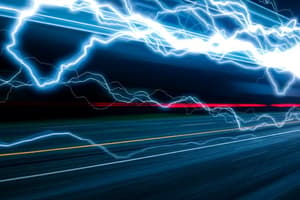Podcast
Questions and Answers
What is electric charge carried by?
What is electric charge carried by?
Electrons and protons
What is the SI unit of electric charge?
What is the SI unit of electric charge?
Coulomb
An electron has a charge of _____ coulomb.
An electron has a charge of _____ coulomb.
1.6 x 10-19
What is drift velocity in conduction electrons?
What is drift velocity in conduction electrons?
What is the formula for drift velocity (V)?
What is the formula for drift velocity (V)?
What is another term for free electrons?
What is another term for free electrons?
What does the electromotive force (emf) represent?
What does the electromotive force (emf) represent?
The SI unit of emf is _____ per coulomb.
The SI unit of emf is _____ per coulomb.
What is the standard unit of electric power?
What is the standard unit of electric power?
What is the relationship between electrons and electrical resistance?
What is the relationship between electrons and electrical resistance?
If a current of 2 A flows through a wire for 30 seconds, how many coulombs pass through the wire?
If a current of 2 A flows through a wire for 30 seconds, how many coulombs pass through the wire?
Study Notes
Electric Charge
- Carried by electrons (negative charge) and protons (positive charge).
- The SI unit of electric charge is the coulomb (C).
- Charge of one electron or proton is approximately 1.6 x 10^-19 C.
- Copper serves as a universal reference conductor, with 1 cm³ containing about 8.5 x 10²² free electrons.
Drift Velocity of Conduction Electrons
- Drift velocity is minimal due to a high density of free electrons in conductors.
- Key formula components:
- I = current in amperes (A)
- n = electron density in electrons/m³
- e = charge per electron (1.6 x 10^-19 C)
- A = cross-sectional area of the conductor in m²
- V = drift velocity of the electrons in m/s.
Electric Current
- Defines the rate of electron movement in a given material.
- SI unit of current is the ampere (A), equivalent to coulombs per second.
- Example calculation context: For a 2 A current flowing for 30 seconds, the total coulombs can be calculated.
Electromotive Force (emf)
- Emf is the energy per coulomb of charge provided by a cell, battery, or generator.
- SI unit of emf is volts (V), equivalent to joules per coulomb (J/C).
- Example: To calculate the charge delivered by a battery with a 100 V potential difference performing 500 J of work.
Electric Energy and Power
- Electric energy operates various devices with the standard unit as joules (J) or kilojoules (kJ).
- Other common measures include kilowatt-hour (kWh) and megawatt-hour (MWh).
- Electric power is the rate of energy consumption, measured in watts (W).
- Common relationships include W = E/t, where W is electric energy, E is emf or voltage, and t is time.
Electric Resistance
- Resistance opposes electron flow, measured in ohms (Ω).
- Resistivity is a property specific to materials, dependent on their dimensions and units (ohm-m for SI).
- At 20°C, the resistivity of annealed copper wire must be considered in calculations.
Circular Mil (CM)
- An older unit used to specify wire cross-sectional areas, equal to the area of a circle with a diameter of 1 mil.
- Relevant formulas for converting areas exist between circular mils and square mils.
Example Calculations
- For a copper wire with a diameter of 1.6 mm and length of 10 m, the number of free electrons can be calculated using given dimensions.
- Electric power consumption example: A radio receiver running at 0.9 A and 110 V for 3 hours daily across 10 days requires energy consumption calculations.
Studying That Suits You
Use AI to generate personalized quizzes and flashcards to suit your learning preferences.
Related Documents
Description
Explore the concepts of electric charge carried by electrons and protons, along with the drift velocity of conduction electrons. Understand the significance of the SI unit of electric charge, the coulomb, and the impact of free electrons in conductors. This quiz is designed to test your knowledge on these fundamental physics principles.




